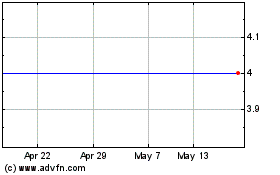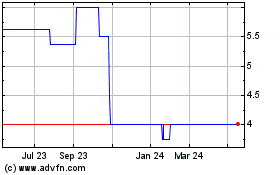Aisi Realty Public Limited Half Yearly Report -2-
September 05 2012 - 2:00AM
UK Regulatory
H1 2011 H1 2012
----------------------- ------------ -----------------------------------------
Recurring Non Recurring- Total
Expenses One-off
Expenses
----------------------- ------------ ---------- --------------- ------------
Revenues 1 184.633 757.502 757.502
----------------------- ------------ ---------- --------------- ------------
Payroll 2,3 251.029 355.329 284.571 639.900
----------------------- ------------ ---------- --------------- ------------
Public Entity,
Audit & Accounting 372.676 177.092 177.092
----------------------- ------------ ---------- --------------- ------------
Legal/ Consulting
Fees 245.378 413.614 298.296 711.910
----------------------- ------------ ---------- --------------- ------------
Directors/ Management
remuneration
4 1.485.246 308.400 308.400
----------------------- ------------ ---------- --------------- ------------
Operating expenses2 314.029 297.226 297.226
----------------------- ------------ ---------- --------------- ------------
Total Expenses 2.668.358 1.551.661 582.867 2.134.528
----------------------- ------------ ---------- --------------- ------------
Net Operating (2.483.725) (794.159) (1.377.026)
Profit (Loss)
----------------------- ------------ ---------- --------------- ------------
1. Full effect of current leases is expected in H2-12
2. Large part of H1-11 payroll and operating expenses
was paid after the Narrowpeak deal in July-August
2011
3. H1-12 includes Director Ukraine severence pay
and AISI Realty Capital LLC expense reimbursement
4. Directors as well as CEO and CFO have deferred
payment of their remunaration to assist company's
liquidity
During the period, the first two tranches of the Capital Injection
$4million capital injection, approved by the Company's
shareholders in July 2011 as part of the Narrowpeak
deal, were injected into Aisi with two existing shareholders
contributing $1.500.000 and two new ones an additional
$850.000.
The Group continues its prudent and optimal cash Liquidity Management-Cash
flow management in line with liquidity needs and Flow Risk
at the end of the period the Company had $1 million
in immediate cash liquidity. With Terminal Brovary
currently 83% let, the Group has now turned operationally
cash flow positive. Management entered into discussions
with the European Bank for Reconstruction and Development
(EBRD) to restructure the Terminal Brovary construction
loan facility and hopes to provide a positive update
on this initiative in due course.
2. Regional Economic Developments
Ukraine
The Ukrainian economy continued to grow, although
at a slower pace, by 2% year on year ('YoY') in
Q1 2012 down from 4,7% YoY recorded in Q4 2011.
This deceleration in growth was mainly driven by
a slump in the industrial sector due to weakened
international demand for metals, particularly from
the Eurozone and Russia, impacting Ukraine's steel
industry.
On the other hand, the consumer sector retained
its upward trend supported by robust real wage growth
and slowing inflation. Retail sales recorded a growth
of 13,9% YoY in April whilst real wages grew by
16,9% in the same month from 12,6% YoY and from
15,8% in the prior month.
The downward trend of headline inflation continued,
receding for 10 consecutive months (from a peak
of 11,9% in June 2011) turning negative by 0,5%
in May 2012. The deflation stemmed from the sharp
decline in food prices. Lower inflation allowed
the National Bank of Ukraine to cut its central
interest rate by 25bps to 7,50% in late March, which
has been unchanged since August 2010.
The Parliamentary elections scheduled for October
2012 are considered important in terms of both the
political climate within the country and the nation's
relationships with Russia and the European Union.
In relation to currency movements, the UAH maintains
its level against the major currencies but the impact
of the upcoming elections has the potential to cause
some devaluation.
The new government (led by social democrats-PSD) Romania
,which has been formed following a turbulent period,
successfully negotiated with the IMF-EU the upward
revision of 2012 deficit targets thus facilitating
a restoration of public wages to their early 2010
levels, whilst in parallel it declared its commitment
to the present IMF-EU austerity program. The government
instigated referendum failed to impeach the ex President,
turnout being less than 45%, short of the 50% needed,
continuing the political uncertainty and the poor
relations between the two political institutions.
It should be noted that Romania has made visible
progress in fiscal consolidation over the last couple
of years, reducing the general government deficit,
on a cash basis, from 7,3%-of-GDP in 2009 to 4,2%-of-GDP.
The Romanian economy, affected by the uncertainty
in the euro-area, a reducing demand for its exports
and severe weather, slightly contracted by 0,1%
quarter on quarter ('QoQ')in Q1 2012. At the same
time, the current account deficit ended at 4,1%
of GDP in April, far from the unsustainable pre
crisis 10-13% levels. While annual inflation slightly
increased to 2% in June, the first increase in eight
months after the historical low of 1,79% at the
end of May 2012, retail sales grew by 3,8% YoY in
Q1 2012 and infrastructure works by 14,8% YoY, the
latter providing the strongest boost to investment
(+11,8%).
Domestic financial markets were affected negatively
from the political volatility with the EUR/RON FX
rate fluctuating between 4,25-4,40 during the period.
Meanwhile, the National Bank of Romania halted its
monetary easing policy during Q2 2012, retaining
central interest rates at 5,25%.
The Bulgarian economy remained in positive territory Bulgaria
as real GDP grew by 0,5% in the first quarter of
2012, still stronger than the EU-27 average of +0,1%.
However, close trade links with Greece as well as
bank deleveraging and a large surplus of uncompleted
housing stock have stalled further economic recovery.
However, individual consumption, driven mainly by
rising wages, 8,8% YoY, and easing inflation, 1,6%
YoY in June, recorded a modest growth of 1% YoY
in Q1 2012, but was still 5,4% below its pre-crisis
peak.
Positive signs came from the banking sector which
remains profitable, as net profit after tax jumped
by 11,7% YoY in Q1 2012 to BGN 176 million (EUR
90 million or 0,2% of GDP), compared with profits
of BGN 102 million in Q4 2011. Bulgaria's banking
system remains well-capitalised as the loans-to-deposits
ratio dropped from 123,32% in November 2008, the
highest level of the decade, to 101,8% in February
2012, the lowest level since Q1 2008.
3. Real Estate Market Developments
3.1. Ukraine
The first half of 2012 was characterised by a strengthened General
demand in the Ukrainian property market, especially
for high quality, income generating, premises in
Kiev. This interest has driven the compression of
yields, which despite this, are still higher than
in other CEE countries.
The national vacancy rate remained stable at 12% Logistics Market
as no new logistics properties were put into operation
during the first half of 2012 in the Greater Kiev
area. The forthcoming increase in commercial activity
and strengthening of occupier demand is expected
to lead to a further fall in vacancy and an upward
pressure on logistics rents.
The upward trend of demand continued in the first Office Market
semester of 2012 mainly supported by manufacturing,
finance and business services companies which relocated
to larger premises, better quality buildings and/or
better locations.
Despite the increasing interest from new retail Retail Market
operators to enter into the Kiev market, the lack
of critical mass of quality retail space is preventative.
The rapid delivery of new quality projects in the
coming years is expected to stimulate retailer expansion.
As no new completed projects entered the market
during the first semester of 2012, vacancy rates
slightly decrease near to 2,5% from 3% with rental
levels remaining unchanged.
3.2. Romania
During the first semester of 2012, the Romanian General
real estate market remained stable despite the economic
and political uncertainties at local and European
levels.
The upward trend of demand continued in the first Logistics Market
half of 2012 supported by various industries such
as electronic components, FMCG distributors, plastics
and fashion. With few projects planned to be delivered
in the remainder of 2012, of which most are purpose
Secure Property Developm... (LSE:SPDI)
Historical Stock Chart
From Jun 2024 to Jul 2024

Secure Property Developm... (LSE:SPDI)
Historical Stock Chart
From Jul 2023 to Jul 2024
